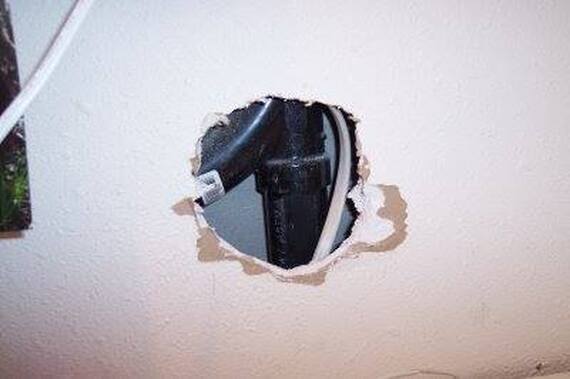The Hidden Dangers of Ignoring Sagging Ceiling Water Damage
Ceiling Water Damage Nightmare: Ignoring Sagging Ceilings
The importance of addressing and not ignoring the hidden dangers of sagging ceiling water damage. While it may be tempting to turn a blind eye to that discolored spot on your ceiling or dismiss the occasional dripping sound as mere inconveniences, doing so can have severe consequences for both your property and your family's safety. In this blog post, we will delve deep into the reasons why homeowner's should never ignore sagging ceiling water damage, shedding light on the potential risks that lie beneath the surface. So, grab a cup of coffee and prepare to uncover the truth about this insidious threat lurking above your heads.

Understanding the causes of sagging ceiling water damage
Ignoring this issue can lead to a cascade of hidden dangers that can wreak havoc on your home and your health. First and foremost, it is crucial to recognize that sagging ceiling water damage is often a symptom of a much larger problem: a leak in the plumbing or a faulty roof. These underlying issues must be addressed promptly ceiling water damage repair to prevent further damage.
Additionally, the presence of stagnant water can lead to the growth of harmful mold and mildew, posing serious health risks to you and your family. Inhaling the spores released by these organisms can lead to respiratory problems, allergies, and even infections. Moreover, sagging ceilings may lose their structural integrity, posing a potential safety hazard as they could collapse at any time. Don't dismiss the seemingly innocent drooping ceiling as a cosmetic issue – tackle it head-fix ceiling water damage on to protect your home, your loved ones, and your peace of mind.
The hidden dangers of ignoring sagging ceiling water damage
It may be tempting to simply ignore a small water stain or a sagging spot on your ceiling, but this can turn into a nightmare situation if left untreated. Firstly, the structural integrity of your home is at risk. When water seeps into your ceiling, it weakens the overall structure, making it susceptible to collapse. This poses a significant safety hazard to everyone living in the house.
In addition, untreated water damage can lead to the growth of mold and mildew. These fungi thrive in moist environments, and your sagging ceiling acts as the perfect breeding ground. Why ceiling sagging should concern every homeowner is because not only will this affect the air quality in your home, but it can also lead to health issues such as respiratory problems and allergies. Ignoring sagging ceiling water damage is a gamble that no homeowner should take. A pillowing ceiling dangerous scenario can also emerge, leading to potential structural issues. Additionally, drooping drywall is a clear sign of sagging ceiling from water damage which can be hazardous if left unchecked.
The financial repercussions of ignoring sagging ceiling water damage
Many homeowners fail to realize the financial repercussions that can arise from neglecting this issue. From the outside, a sagging ceiling water damage may seem like a minor inconvenience, but the reality is that it could indicate a much larger problem. When water infiltrates the structural integrity of our homes, it can lead to extensive damage, ranging from weakened foundations to mold infestations. Ignoring the signs of sagging ceilings puts not only the integrity of our homes at risk but also our wallets.
The cost of repairing ceiling water damage goes far beyond the materials and labor required to fix it; it encompasses the entire restoration process and the potential collateral damage that could occur if underlying issues such as humidity, ventilation, and water supply problems are left unaddressed. Thus, swift action is needed to protect our homes and our financial well-being from the hidden dangers of sagging ceiling water damage. This requires the expertise of plumbers, handymen, and renovation experts who can address issues related to glass, privacy, brick integrity, carpet drying, kitchen, toilet, and basement areas, ensuring a comprehensive approach to moisture management and structural safety.
Signs to look out for and when to take action
One of the first signs to look out for in cases of water damage is a sagging or bulging ceiling, which could indicate a severe water leak or even a structural issue. Additionally, if you notice any discoloration or staining on the ceiling, it is crucial to take immediate action. These signs, which may stem from issues like plumbing faults, floods, or inadequate drainage, should never be brushed off as mere cosmetic issues, as they could be indicative of a deeper problem that requires water damage restoration. Such ceiling damage is a significant concern in home improvement and ceiling leak scenarios and often necessitates professional intervention.
When it comes to water damage, time is of the essence, and waiting too long to address the issue can lead to further complications such as mold growth, weakened structural integrity, and even a potential collapse. Don't ignore the warning signs – be proactive and consult with a professional to assess the extent of the damage and determine the best course of action. Your safety and the integrity of your home depend on it. Key considerations should include checking for water damaged ceilings, ensuring proper ventilation, using a dehumidifier to control moisture, inspecting for condensation issues, and conducting a thorough renovation and inspection process if necessary. Additionally, look into waterproofing solutions, mold remediation, and pest control measures to prevent future damage and ensure a healthy living environment.
Steps to address sagging ceiling water damage
That's why it is crucial to address sagging ceiling water damage as soon as it becomes apparent. The first step in addressing this problem is identifying the source of the water leak. Whether it is a burst pipe, a leaky roof, or faulty plumbing, it is important to fix the source of the water damage to prevent further issues. Once the source is identified and fixed, the next step is to assess the extent of the damage.
This may involve removing any wet or minor ceiling water damage materials, such as drywall or insulation, and thoroughly drying the affected area. Additionally, it is crucial to check for any signs of mold growth, as stagnant water can provide the perfect breeding ground for mold and mildew. By promptly addressing sagging ceiling water damage and following these steps, homeowners can prevent further damage, maintain a safe living environment, and avoid costly repairs in the future. Identifying sagging ceiling signs early can help in taking timely action. The sagging of ceiling may also affect sagging ceiling wallpaper, which should be checked and replaced if needed. Understanding the sagging ceiling cost involved in repairs can help homeowners budget accordingly.
Conclusion
In conclusion, addressing and resolving sagging ceiling water damage is not something that should be taken lightly. As we have discussed throughout this blog post, the consequences of ignoring this issue can be serious and far-reaching. From potential health risks to damaged property value and financial repercussions, it is clear that swift action is necessary.
Don't let your repair drywall ceiling water damage crumble, reach out to us today for a free quote and take the necessary steps to protect your health, property, and financial well-being. We are here to help you navigate through this popcorn ceiling water damage and ensure a safe and secure living environment. Remember, time is of the essence when it comes to sagging ceiling water damage – don't wait, search for ceiling water damage repair near me and contact us now.



